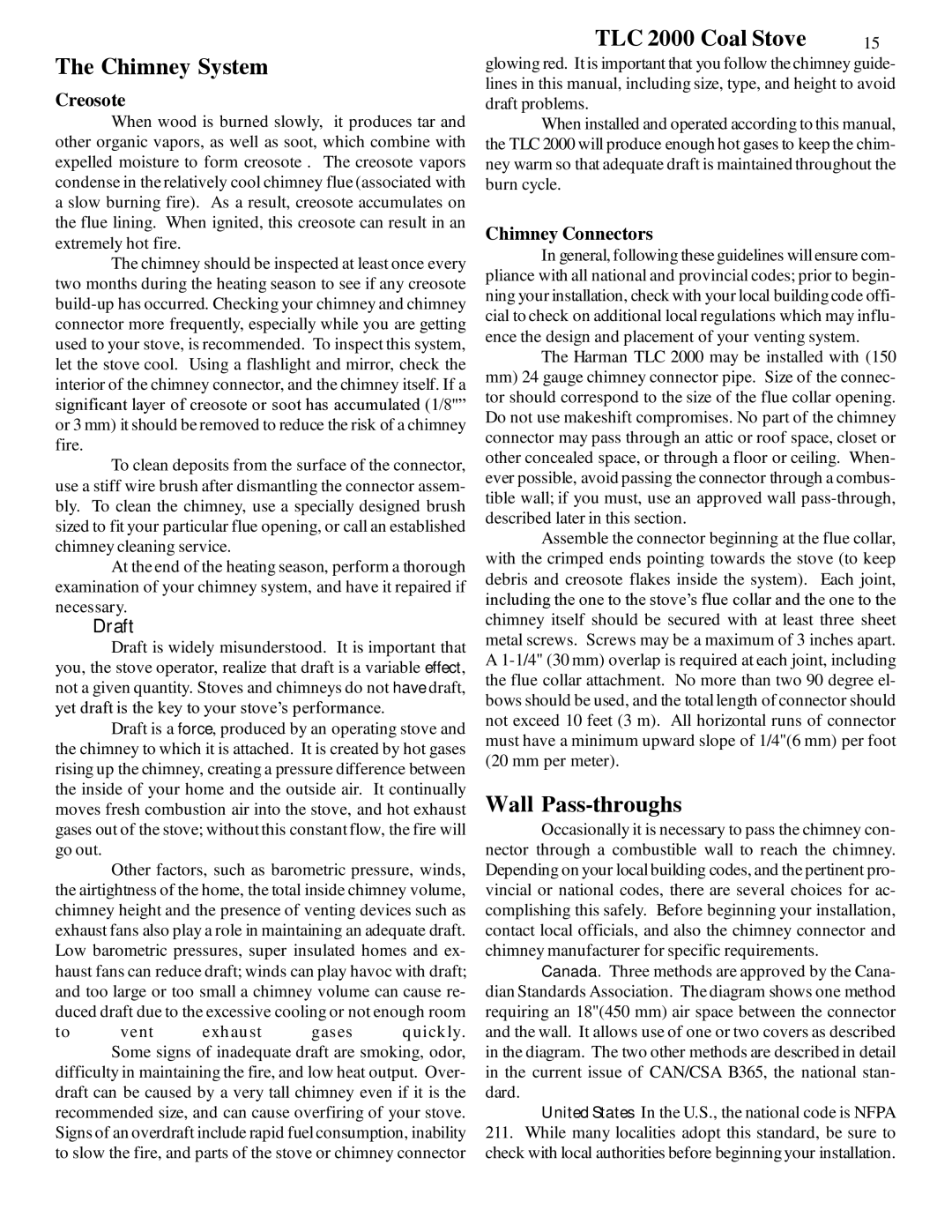The Chimney System
Creosote
When wood is burned slowly, it produces tar and other organic vapors, as well as soot, which combine with expelled moisture to form creosote . The creosote vapors condense in the relatively cool chimney flue (associated with a slow burning fire). As a result, creosote accumulates on the flue lining. When ignited, this creosote can result in an extremely hot fire.
The chimney should be inspected at least once every two months during the heating season to see if any creosote build-up has occurred. Checking your chimney and chimney connector more frequently, especially while you are getting used to your stove, is recommended. To inspect this system, let the stove cool. Using a flashlight and mirror, check the
interior of the chimney connector, and the chimney itself. If a significant layer of creosote or soot has accumulated (1/8"”
or 3 mm) it should be removed to reduce the risk of a chimney fire.
To clean deposits from the surface of the connector, use a stiff wire brush after dismantling the connector assem- bly. To clean the chimney, use a specially designed brush sized to fit your particular flue opening, or call an established chimney cleaning service.
At the end of the heating season, perform a thorough examination of your chimney system, and have it repaired if necessary.
Draft
Draft is widely misunderstood. It is important that you, the stove operator, realize that draft is a variable effect,
not a given quantity. Stoves and chimneys do not have draft, yet draft is the key to your stove’s performance.
Draft is a force, produced by an operating stove and the chimney to which it is attached. It is created by hot gases rising up the chimney, creating a pressure difference between the inside of your home and the outside air. It continually moves fresh combustion air into the stove, and hot exhaust gases out of the stove; without this constant flow, the fire will go out.
Other factors, such as barometric pressure, winds, the airtightness of the home, the total inside chimney volume, chimney height and the presence of venting devices such as exhaust fans also play a role in maintaining an adequate draft. Low barometric pressures, super insulated homes and ex- haust fans can reduce draft; winds can play havoc with draft; and too large or too small a chimney volume can cause re- duced draft due to the excessive cooling or not enough room
to vent exhaust gases quickly. Some signs of inadequate draft are smoking, odor, difficulty in maintaining the fire, and low heat output. Over- draft can be caused by a very tall chimney even if it is the recommended size, and can cause overfiring of your stove. Signs of an overdraft include rapid fuel consumption, inability to slow the fire, and parts of the stove or chimney connector
15
glowing red. It is important that you follow the chimney guide- lines in this manual, including size, type, and height to avoid draft problems.
When installed and operated according to this manual, the TLC 2000 will produce enough hot gases to keep the chim- ney warm so that adequate draft is maintained throughout the burn cycle.
Chimney Connectors
In general, following these guidelines will ensure com- pliance with all national and provincial codes; prior to begin- ning your installation, check with your local building code offi- cial to check on additional local regulations which may influ- ence the design and placement of your venting system.
The Harman TLC 2000 may be installed with (150
mm)24 gauge chimney connector pipe. Size of the connec- tor should correspond to the size of the flue collar opening. Do not use makeshift compromises. No part of the chimney connector may pass through an attic or roof space, closet or other concealed space, or through a floor or ceiling. When- ever possible, avoid passing the connector through a combus- tible wall; if you must, use an approved wall pass-through, described later in this section.
Assemble the connector beginning at the flue collar, with the crimped ends pointing towards the stove (to keep
debris and creosote flakes inside the system). Each joint, including the one to the stove’s flue collar and the one to the
chimney itself should be secured with at least three sheet metal screws. Screws may be a maximum of 3 inches apart. A 1-1/4" (30 mm) overlap is required at each joint, including the flue collar attachment. No more than two 90 degree el- bows should be used, and the total length of connector should not exceed 10 feet (3 m). All horizontal runs of connector must have a minimum upward slope of 1/4"(6 mm) per foot (20 mm per meter).
Wall Pass-throughs
Occasionally it is necessary to pass the chimney con- nector through a combustible wall to reach the chimney. Depending on your local building codes, and the pertinent pro- vincial or national codes, there are several choices for ac- complishing this safely. Before beginning your installation, contact local officials, and also the chimney connector and chimney manufacturer for specific requirements.
Canada. Three methods are approved by the Cana- dian Standards Association. The diagram shows one method requiring an 18"(450 mm) air space between the connector and the wall. It allows use of one or two covers as described in the diagram. The two other methods are described in detail in the current issue of CAN/CSA B365, the national stan- dard.
United States In the U.S., the national code is NFPA
211.While many localities adopt this standard, be sure to check with local authorities before beginning your installation.
